|
|
|
Sort Order |
|
|
|
Items / Page
|
|
|
|
|
|
|
| Srl | Item |
| 1 |
ID:
157584
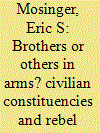

|
|
|
|
|
| Summary/Abstract |
Why do united rebel fronts emerge in some insurgencies, while in other insurgencies multiple rebel groups mobilize independently to challenge the state, and often, each other? I develop a diffusion model of rebel fragmentation in which participation in rebellion spreads, completely or incompletely, through networks of civilians and dissidents. Using this theoretical framework I hypothesize that two factors jointly determine whether a rebel movement remains unified or fragments: the rebels’ investment in civilian mobilization, and the overall level of civilian grievances. The theory predicts that widely shared grievances motivate the formation of many small dissident groups willing to challenge the regime. Given the difficulty of collective action between disparate opposition actors, an emerging rebel movement will tend towards fragmentation when popular grievances are high. Yet extremely high civilian grievances can also help rebels activate broad, overlapping civilian social networks that serve to bridge together dissident groups. Mass-mobilizing rebel groups, benefiting from the participation of broad civilian networks, are most likely to forge and maintain a unified rebel front. I test this theory alongside several alternatives drawn from cross-national studies of conflict using regression analysis. The quantitative evidence lends considerable credence to the role of rebel constituencies in preventing or fomenting rebel fragmentation.
|
|
|
|
|
|
|
|
|
|
|
|
|
|
|
|
| 2 |
ID:
157586


|
|
|
|
|
| Summary/Abstract |
This article analyzes the length of interstate wars and the process of reaching a mutually acceptable bargaining solution. Rational choice scholarship has mainly sought to explain long wars in terms of commitment problems and private information. This article complements these rational choice perspectives by arguing that causal beliefs – a variable not considered by previous research – can also prolong wars by increasing expectations of battlefield performance and slowing down information updating. It illustrates the role of religiously based causal beliefs with the case of one of the longest interstate wars of modern time, the Iran–Iraq War of 1980–88. Even though commitment problems were present, they do not identify the root cause of Iran’s high expected utility of continuing the war, as religiously based causal beliefs played a more prominent role in prolonging the war. Religious causal beliefs constitute a real word mechanism that not only creates different priors about expected military capacity, but also slows down the process of updating beliefs, as battlefield events are not seen as credible information. Although the prevalence of religious conflicts has increased over time, the formation of beliefs and their effects on wars remains understudied when applying rational choice to real world conflicts.
|
|
|
|
|
|
|
|
|
|
|
|
|
|
|
|
| 3 |
ID:
157583


|
|
|
|
|
| Summary/Abstract |
The International Criminal Court’s interventions have prompted debate about the wisdom of criminally prosecuting combatants while attempting to build peace in conflict-ridden societies. Previous research fails to distinguish between different types of trials. Using a large-N dataset of three types of criminal trials undertaken during internal conflict – domestic security trials of rebels, domestic human rights trials of state agents, and international war crimes trials of both – this article tests a theory of the compellent effect of criminal prosecution on conflict termination. We find that, even when accounting for endogeneity, rebel trials are associated with a higher probability of conflict termination, while trials of state agents are weakly associated with conflict persistence. We argue that the former compel the opposition to discontinue fighting, while the latter signal to rebels a lack of government resolve. We also find that the effect of international trials, which at times appear weakly associated with conflict termination, is endogenous to international intervention more generally.
|
|
|
|
|
|
|
|
|
|
|
|
|
|
|
|
| 4 |
ID:
157588
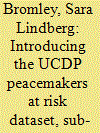

|
|
|
|
|
| Summary/Abstract |
This article introduces new event data on violence against peacekeepers deployed to conflict-affected countries in sub-Saharan Africa between 1989 and 2009. While the practice of peacekeeping is often described as fraught with risk, a shortage of data has left scholars poorly equipped to study this important phenomenon. The Peacemakers at Risk (PAR) dataset records reported incidences of violence resulting in direct peacekeeping personnel fatalities, injuries and kidnappings. Information on the timing, location, outcomes and actors implicated is provided for each recorded event, including information on the nationalities of violence-affected peacekeepers. The dataset also charts reports of fatal violence by peacekeepers. This enables the study of peacekeepers’ use of force and provides a new lens for examining wider questions related to peacekeeping effects and conflict dynamics. Peace operations deployed by the UN as well as other peacekeeping actors are included, allowing for a rich dataset that reflects today’s diverse peacekeeping landscape. The PAR dataset makes possible the evaluation of reigning assumptions regarding peacekeeping intervention and risk, and allows scholars to pose research questions regarding the causes, characteristics and consequences of peacekeeper violence, within and across interventions. This article introduces the criteria and procedures guiding the data collection and presents the data. The article also highlights key patterns emerging from the dataset and identifies a number of potential applications and avenues for future research.
|
|
|
|
|
|
|
|
|
|
|
|
|
|
|
|
| 5 |
ID:
157582
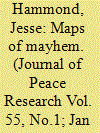

|
|
|
|
|
| Summary/Abstract |
Disaggregated studies of civil violence attempt to predict where violence is most likely to break out within states, but have been limited by a near-exclusive focus on political, economic, and accessibility-based factors in explaining local patterns of violence. These factors are important, but the calculus of military conflict does not focus solely on lootable resources or population distributions. Both states and insurgents try to exert control over geographic territory in order to increase their resource base and political legitimacy. Historic evidence suggests that groups use violence to contest control over strategically important locations that allow them to effectively attack and defend territory. I use GIS and social network analysis to operationalize strategic location based on the network of roads and population settlements that make up a country. I find that during conflicts, locations with high degree and betweenness centrality in the road network – in other words, locations that control access to other areas within the state – are significantly more likely to be fought over, even after controlling for a wide range of variables suggested by previous literature and testing for reporting bias. These findings expand on the previous body of literature studying disaggregated violence and show that the calculus of violence during civil conflict encompasses strategic considerations as well as economic, political, or topographic factors.
|
|
|
|
|
|
|
|
|
|
|
|
|
|
|
|
| 6 |
ID:
157585


|
|
|
|
|
| Summary/Abstract |
Why do only some powerful states choose to develop power projection capabilities? To answer this question, we test the proposition that states choose to develop power projection capabilities when they face a competitive geopolitical environment. This proposition is derived from our theory, which is used to construct a new measure of the level of geopolitical competition that every state in the system faces. This measure incorporates each state’s relative geographic position to every other state in the international system, the relative amount of economic power of those other states, and the degree to which their interests are compatible. We then apply this unique country-year measure to test the proposition that competitive environments are associated with the development of power projection capabilities, as measured by the tonnage of naval ships maintained by each country in each year. We demonstrate that our measure helps explain the degree to which states choose to invest in power projection capabilities. This provides an explanation for why the world has been economically multipolar, but military unipolar, for the past quarter century, and why this might change in the future, as rising powers with incompatible interests are increasing their investment in power projection capabilities.
|
|
|
|
|
|
|
|
|
|
|
|
|
|
|
|
| 7 |
ID:
157580
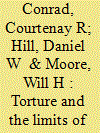

|
|
|
|
|
| Summary/Abstract |
What are the limits of democracy’s positive influence on human rights? In this article, we argue that contested elections and powerful courts provide leaders with different incentives with regard to hiding torture. Because government torture is generally targeted at individuals that voters find threatening, institutions that reflect public opinion – like electoral contestation – are associated with higher levels of government abuse that leave scars on the victim’s body. Other institutions – like powerful courts – protect the rights of political minorities. Leaders in countries with powerful courts prefer plausible deniability of rights violations and consequently employ higher levels of clean torture, which leaves no scars. We test our hypotheses using data from the Ill-Treatment and Torture (ITT) Data Collection Project that distinguish between Amnesty International (AI) allegations of scarring and clean torture. We employ an undercount negative binomial that accounts for AI’s (in)ability to obtain information about torture. The model assumes that some incidents of torture go unreported and allows the extent of underreporting to vary across countries/years. Estimates from the model yield considerable statistical and substantive support for our hypotheses.
|
|
|
|
|
|
|
|
|
|
|
|
|
|
|
|
| 8 |
ID:
157587
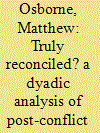

|
|
|
|
|
| Summary/Abstract |
In the aftermath of civil war or violent internal conflict, one of the key peacebuilding challenges is the reconciliation of former enemies who are members of the same small-scale societies. A failure of social reintegration may contribute to what is known as a conflict trap. To detect lingering hostile attitudes among a community’s various factions is crucial, but the approaches adopted in previous studies tend to focus on the impact of conflict on one or other aggregated indicator of social cohesion rather than on how violence-affected individuals regard and act towards their fellow community members. Here we demonstrate the value of concentrating on this latter dyadic component of social interactions and we use behavioural experiments and a social tie survey to assess, in an appropriately disaggregated manner, social cohesion in a post-conflict setting in northern Uganda. Whereas in self-reported surveys, ex-combatants appear to be well-connected, active members of their communities, the experiments unveil the continued reluctance of other community members to share or cooperate with them; fewer resources are committed to ex-combatants than to others, which is statistically significant. The dyadic nature of our analysis allows us to detect which groups are more prone to discriminate against ex-combatants, which may help facilitate targeted interventions.
|
|
|
|
|
|
|
|
|
|
|
|
|
|
|
|
| 9 |
ID:
157581


|
|
|
|
|
| Summary/Abstract |
Why do some civil wars feature the mass killing of civilians while others do not? Recent research answers this question by adopting a ‘varieties of civil war’ approach that distinguishes between guerrilla and conventional civil wars. One particularly influential claim is that guerrilla wars feature more civilian victimization because mass killing is an attractive strategy for states attempting to eliminate the civilian support base of an insurgency. In this article, I suggest that there are two reasons to question this ‘draining the sea’ argument. First, the logic of ‘hearts and minds’ during guerrilla wars implies that protecting civilians – not killing them – is the key to success during counterinsurgency. Second, unpacking the nature of fighting in conventional wars gives compelling reasons to think that they could be particularly deadly for civilians caught in the war’s path. After deriving competing predictions on the relationship between civil war type and mass killing, I offer an empirical test by pairing a recently released dataset on the ‘technology of rebellion’ featured in civil wars with a more nuanced dataset of mass killing than those used in several previous studies. Contrary to the conventional wisdom, I find that mass killing onset is more likely to occur during conventional wars than during guerrilla wars.
|
|
|
|
|
|
|
|
|
|
|
|
|
|
|
|
|
|
|
|
|